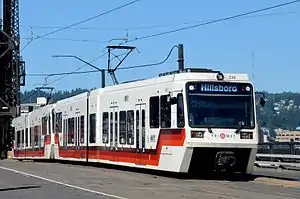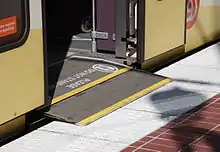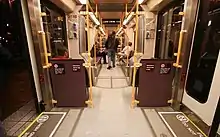Siemens SD660
The Siemens SD660 is a double-articulated, 70%-low-floor light rail vehicle (LRV) manufactured by Siemens Transportation Systems, a division of Siemens AG. It was the first low-floor light rail vehicle to be used in the United States.[1][2] It first entered service in 1997 with its only operator, TriMet, on the MAX light rail system in Portland, Oregon, United States. It was originally known as the SD600.[3]
| Siemens SD660 LRV | |
|---|---|
 A train of SD660s on the Steel Bridge in Portland, Oregon | |
| Manufacturer | Siemens |
| Built at | Sacramento, California |
| Constructed | 1996–2005 |
| Entered service | 1997 |
| Number built | 79 |
| Number in service | 79 |
| Successor | Siemens S700 and S70 |
| Operator(s) | TriMet |
| Specifications | |
| Car length | 91.93 feet (28.02 m) |
| Width | 8.71 ft |
| Height | 13 feet (4.0 m) |
| Low-floor | 70 percent |
| Entry | Level |
| Doors | 8 per car (4 per side) |
| Articulated sections | 3 |
| Maximum speed | 55 mph |
| Acceleration | 3 mph/second |
| Deceleration | 3 mph/second (standard); 5 mph/second (emergency) |
| Electric system(s) | 750 V DC |
| Current collection method | Pantograph |
| Minimum turning radius | 82 feet (25 m) |
| Track gauge | 4 ft 8 1⁄2 in (1,435 mm) |
History
The initial order placed by TriMet (known as Tri-Met at the time), in May 1993, was for 39 cars. It was the first order for low-floor light rail vehicles (LRVs) in North America.[1] The order was subsequently expanded to 46 cars and ultimately to 52.[4] TriMet received the first car, which it numbered 201, in July 1996,[5][6] and the first nine cars entered service on August 31, 1997.[7][8] Siemens retroactively changed the car's model designation from SD600 to SD660, a change relating to its use of AC motors running on 60 Hz instead of DC ones, in 1998.[3] The 52nd car was received by TriMet in April 2000.[9]
TriMet later purchased 27 more SD660s (initially 17 cars, with another 10 added to the order in 2002),[10] which were built between 2003 and 2005. TriMet designated these "Type 3" in its fleet and numbered them 301–327. The last car was delivered in March 2005.[11]
All 79 SD660 cars were originally equipped with rollsign-type destination signs. TriMet replaced the original signs with LED-type signs in a two-year conversion program that lasted from fall 2014[12] to August 2016.[13]
Features
- 70% low-floor design – a first for light rail in North America
- Bridgeplate wheelchair ramps. These are located at two of the four doorways on each side of an LRV, the two closest to the car's center.[1]
- Bi-directional (or "double-ended"), with operating cabs at both ends[1]
- Interoperability with TriMet's "Type 1" high-floor cars[7][8]


References
- "SD660 Light Rail Vehicle Technical Information" (PDF). Siemens Transportation Systems. 2005-05-15. Archived from the original (PDF) on 2005-05-15.
- Vantuono, William C. (July 1993). "Tri-Met goes low-floor: Portland's Tri-Met has broken new ground with a procurement of low-floor light rail vehicles. The cars will be North America's first low-floor LRVs". Railway Age. pp. 49–51. ISSN 0033-8826.
- "LA And Portland Get New-Design LRVs". International Railway Journal. October 1993. pp. 26–27. ISSN 0744-5326.
- "Systems News". Tramways & Urban Transit. UK: Ian Allan Publishing/Light Rail Transit Association. October 1998. p. 397. ISSN 1460-8324.
- Oliver, Gordon (September 26, 1997). "Tri-Met expands light-rail car order". The Oregonian. p. B6.
- Oliver, Gordon (August 1, 1996). "MAX takes keys to cool new model". The Oregonian. p. D1.
- Wolinsky, Julian (Winter 1998). "Block Signals [regular news section]". The New Electric Railway Journal. No. 38. p. 11. ISSN 1048-3845.
- "World News Review". Light Rail & Modern Tramway. No. 718. UK: Ian Allan Publishing/Light Rail Transit Association. October 1997. p. 395. ISSN 0964-9255.
- O'Keefe, Mark (September 1, 1997). "New MAX cars smooth the way for wheelchairs". The Oregonian. p. B12.
- "Systems News". Tramways & Urban Transit. No. 750. UK: Ian Allan Publishing/Light Rail Transit Association. June 2000. p. 227. ISSN 1460-8324.
- "Systems News". Tramways & Urban Transit. No. 776. UK: Ian Allan Publishing/Light Rail Transit Association. August 2002. p. 308. ISSN 1460-8324.
- "Systems News". Tramways & Urban Transit. No. 809. UK: Ian Allan Publishing/Light Rail Transit Association. May 2005. p. 196. ISSN 1460-8324.
- "Worldwide Review" (regular news section). Tramways & Urban Transit magazine, March 2015, p. 121. UK: LRTA Publishing.
- "Worldwide Review" (regular news section). Tramways & Urban Transit magazine, November 2016, p. 440. UK: LRTA Publishing.
External links
 Media related to Siemens SD660 at Wikimedia Commons
Media related to Siemens SD660 at Wikimedia Commons